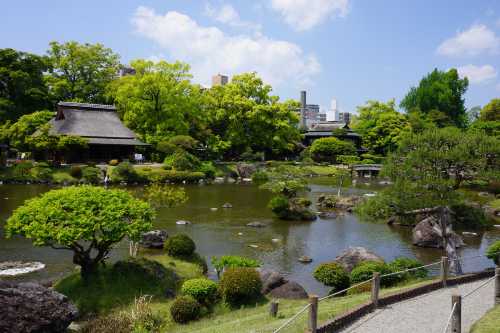Popular Trip Moments
Kumamoto Travel|The Aerial Poet: Street Corners, Mountain Views, and Fairy Tales | The most classic Japanese coffee shop breakfast ✨ Hoshino Coffee Shop allows you to enjoy the exquisite retro luxury atmosphere | [Tangible Cultural Property] Enjoy a cup of coffee while watching the city electricity pass by the window❤️Elegant retro-style Japanese teahouse | Sakura refugees found a surprise in Kyushu | Kyushu Dreaming: Your Ultimate Must-See & Must-Eat Guide! 😍🌸 | Kumamoto Accommodation Review: GRIDS PREMIUM HOTEL — A Modern and Detailed Urban Hostel | A cafe where you can enjoy a combination of Japanese and Western styles | Kumamoto One-Day Travel Proposal|The Perfect Balance Between Historic Sites and Bustling Streets | The Unbreakable Spirit: My Return to Kumamoto Castle | [Kumamoto Takahashi Inari Shrine⛩️] One of Japan's five major Inari shrines! The impressive vermilion torii gates | Too cute! Kiyomasa cocktail set 🍸 | 🇯🇵Kumamoto Michelin-rated Pork Cutlet Rice🐷 Pilgrimage Guide | Hiking must go to the secret wetland 🌿|Aso Volcano Area | Kumamon doll-shaped cake and horse meat minced cutlet ♡ | A cafe with adorable original cocktails | Morning with a view of Kumamoto Castle ♡ | I am Kumamon, not the Formosan black bear. | Experience the history and charm of Kumamoto Castle Town at Sakura-no-Babajo Castle Garden | Climb up Kumamoto Castle and experience the city's symbolic legacy of history and resilience | Step into Kato Shrine and feel the power of history and faith | One Piece, Kumamon Tour | Kumamoto's famous confectionery "Homare no Jindaiko" is now available as soft serve ice cream! | Adorable! Kumamon-themed meat buns | Kyushu Nature Tour | Kumamoto Castle 🏯History and 🇯🇵Rebirth Tour | 🇯🇵 Japan 7 Days Itinerary | Kumamoto Sakura Road ~ Great
Recommended Attractions at Popular Destinations
Popular Attractions in Zanzibar Island | Popular Attractions in Singapore | Popular Attractions in Sydney | Popular Attractions in Beijing | Popular Attractions in Osaka | Popular Attractions in Tokyo | Popular Attractions in Paris | Popular Attractions in Dubai | Popular Attractions in Walt Disney World Resort | Popular Attractions in Shanghai | Popular Attractions in Bali | Popular Attractions in Melbourne | Popular Attractions in Iguazu National Park(Argentina) | Popular Attractions in London | Popular Attractions in Kuala Lumpur | Popular Attractions in Los Angeles | Popular Attractions in West Lake | Popular Attractions in Las Vegas | Popular Attractions in New York | Popular Attractions in Kyoto | Popular Attractions in Phuket | Popular Attractions in Barcelona | Popular Attractions in Chefchaouene | Popular Attractions in Bangkok | Popular Attractions in Rome | Popular Attractions in Chengdu | Popular Attractions in Madrid | Popular Attractions in Florence | Popular Attractions in Istanbul | Popular Attractions in Jungfrau Region
Popular Attractions
Red Gate Palace | House of the Xue Family | Cuihua Mountain·Qinling Zhongnanshan Unesco Global Geopark | Xian Banpo Museum | Wangxian Bridge | Songzilaifeng Bridge | Emperor Qinshihuang's Mausoleum Site Museum | Huajue Lane, the Great Mosque | Shaanxi History Museum | Qinglong Temple | West Park | Puji Temple | Putuoshan Duobao Tower | Yang Guan | Mingsha Mountain And Crescent Spring | Lin Fung Temple | Lin Kai Temple | The Submarine Villages | Zhangjiajie Ten Mile Gallery | Tongguling Scenic Spot | 天理教 浜益分教会 | Park | Komyoji | Hindu temple | Sauer Prairie Kame Forest Preserve | Minigolf und Pit-Pat Bobingen | Acadia Wellness | La forêt de St Amand Les eaux.. la Drève.. | Gajanan maharaj temple | Magistrat der Stadt Bremerhaven - Amt für Jugend, Familie und Frauen
Popular Restaurants in Kumamoto
Aoyagi | Katsuretsutei Shinshigai Honten | Suganoya Kamitori | Kokutei | Tengaiten | Yakinikukan Sairo Shimizuten | Umazakura Shimotori | FRENCH RESTAURANT “LES CÉLÉBRITÉS” | Gorohachi Honten | Ineya Kumamoto | Buffet Dining Asoshed | Umakassai | tokunagakita | Ogata | SPACE KUMAMOTO | Yoshiya | Komurasaki Kamitori Chuo | Yakiniku Senshoh | Yokobachi | Furumachi sen | Chez Tani, Ezu | Beer Restaurant Oden | SAN-LEE-TON | Nagasaki Jiro Kissashitsu | Forno & Bar Pino | Campagne | Patisserie Trois Grues | Torattoriarosso | Akagumi Ramen | Murakami Karashi Renkon
Popular Ranked Lists
Popular Luxury Hotels in Guatemala | Popular Luxury Hotels in Sweden | Popular Trending Attractions in Kaifeng | Popular Trending Attractions in Deqing | Top 50 Must-Visit Restaurants in Vienna | Popular Trending Attractions in Edinburgh | Top 20 Trending Attractions in Suzhou | Popular Trending Attractions in London | Top 20 Must-Visit Restaurants in Xuzhou | Popular Luxury Hotels in French Saint Martin | Top 10 Luxury Hotels in Canada | Top 10 Luxury Hotels in Montenegro | Popular Trending Attractions in Anji | Popular Trending Attractions in Rizhao | Top 50 Must-Visit Restaurants in Macau | Popular Trending Attractions in Xiangyang | Top 50 Must-Visit Restaurants in Shanghai | Top 10 Trending Attractions in Seoul | Popular Luxury Hotels in Malta | Top 50 Must-Visit Restaurants in Dubai | Top 50 Must-Visit Restaurants in Songyang | Popular Luxury Hotels in Belarus | Popular Trending Attractions in Zhangjiakou | Top 10 Luxury Hotels in Ireland | Popular Luxury Hotels in Costa Rica | Top 10 Luxury Hotels in Dominican Republic | Popular Luxury Hotels in Antigua and Barbuda | Popular Luxury Hotels in Niger | Popular Trending Attractions in Guiyang | Top 20 Must-Visit Restaurants in Tonglu
About
Payment methods
Our partners
Copyright © 2025 Trip.com Travel Singapore Pte. Ltd. All rights reserved
Site Operator: Trip.com Travel Singapore Pte. Ltd.
Site Operator: Trip.com Travel Singapore Pte. Ltd.















